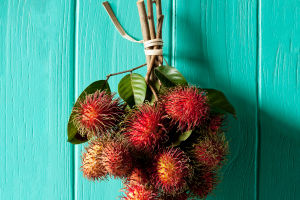Passion fruit is a magical fruit.
When the fruit is ripe, cutting open the outer shell of the passion fruit releases a strong aroma of various fruits, making it difficult to distinguish which fruit scent it resembles. It seems to have hints of mango, pineapple, and lemon, smelling particularly delightful.
However, when you first start eating passion fruit, it can be a bit challenging to try. Just a small spoonful brought to the mouth causes a sourness that makes you scrunch up your eyebrows, and you dare not take another bite. Why does passion fruit smell so fragrant but taste so sour?
Rich in Vitamin C
People who have taken vitamin C tablets may know that holding them in their mouth can taste a bit sour. Passion fruit contains ten times the vitamin C found in apples, earning it the title of 'king of vitamin C fruits,' which explains its intense sourness compared to other fruits.
Passion fruit is rich in nutrients, containing a large amount of fiber, 17 essential amino acids, vitamins A, and B vitamins, protein, folic acid, calcium, potassium, phosphorus, iron, and other substances. Therefore, many people love to eat it despite its sourness.
Some marketers in the market promote passion fruit with the words "pure sweetness" in front of it to highlight its uniqueness, or spare no effort to boast that the passion fruit they sell has been improved and imported as a "pure sweet" type, which is not very reliable.
Are there really sweet passion fruits?
Actually, there are passion fruits that are perceived as "sweet," namely the golden passion fruit. Its sweetness can reach up to 20 degrees, requiring no added honey, and can be eaten directly after cutting open, almost purely sweet.
Compared to regular passion fruit, its juice content is 15-25% higher, with a more intense fragrance, sweetness without sourness, and five times the sweetness of purple passion fruit.
If you want purple or red passion fruit to taste less sour, there are methods. Generally, after the fruit is picked, it is stored in a ventilated and dry place for a few days until the skin wrinkles slightly. At this point, the sweetness of the flesh will increase, the acidity will decrease, and the aroma will become more intense, making it less sour when eaten.
If you want to increase the sweetness, you can also eat it with honey, which adds more flavor.
How to choose
1. Look at the skin
Fresh passion fruit should have plump, smooth outer skin with a glossy appearance and no spots or depressions. Additionally, its color should be bright yellow or purple, indicating freshness.
2. Touch it
Fresh passion fruit should be firm, not soft. If you gently pinch it and feel the hardness of the fruit, it means the passion fruit is fresh and tasty.
3. Smell it
Fresh passion fruit should have a faint aroma. If you can't smell anything, the passion fruit may not be fresh.
In the world of passion fruit, sourness and sweetness intertwine, and nutrition and deliciousness coexist. Whether exploring the sweet taste of fresh fruit or chasing the refreshing acidity of vitamin C, people are addicted to the charm of this magical fruit. Let us savor the sweetness of life in the fragrance of passion fruit!


